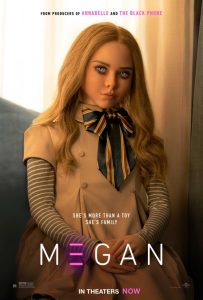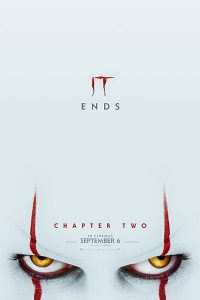Digital Girl in an Analog World: Josh Pearce and Arley Sorg Discuss M3GAN
 Plenty of other killer robot and creepy doll movies to make comparisons to—take your pick—and from the trailer you can pretty much predict the arc of the plot. But there’s something about M3GAN. It seems to have taken on a life of its own.
Plenty of other killer robot and creepy doll movies to make comparisons to—take your pick—and from the trailer you can pretty much predict the arc of the plot. But there’s something about M3GAN. It seems to have taken on a life of its own.
M3GAN is constructed from very basic building blocks: Orphaned girl’s (Violet McGraw) aunt (Allison Williams) gives her a robot (Amie Donald/Jenna Davis) as a replacement for absent human connection, with poorly defined parameters; robot gets stabby. The film is directed by Gerard Johnstone (who previously wrote and directed the excellent low-budget horror/comedy, Housebound), and his shot compositions for M3GAN are slick on a technical level, fitting neatly with the high-tech setting of its killer robotics plot. (Its entirely standard, Frankenstein creation-turning-on-its-creator plot.)
Josh: I’m kind of surprised how good a response this movie is getting. I think it’s a perfectly fine movie, but I left the theater feeling like it was pulling its punches. It was really tame. I guess I didn’t fully realize it was a PG-13 movie while I was watching it, so I kept expecting more kills, bloodier kills, like a full-on slasher movie. Still, it’s put together pretty well for such a modest budget.
Arley: I was trying to think about this movie in terms of the average viewer as opposed to the way that we might see the movie. The way that we’re going to respond to it is a little bit more critical than the average viewer, because we’re intentionally analyzing. I think this is a situation where the movie is hitting the right marks, and the audience responds to that.
Josh: I guess so, but I felt like it was missing some marks, pacing-wise. It probably could have been tighter, like a more efficient movie. I think it’s about 80% of the way to being a really tightly plotted thriller.
Arley: You’re right that if this were a serial killer movie, you would expect it to ratchet up the violence. Serial killer movies really start slow—one kill, two kills, and then the frequency speeds up and then you have the “final girl.” But this, I think, was trying to be a more atmospheric type of horror, which comes down to a lot of the cinematography.
Josh: Yeah, I get what you’re saying about the atmospheric thing, because the other film that came to mind was Ex Machina, and that only has one kill. Basically the rest of it is just, “Is this robot a threat? Is it ethical to have a robot in this position?” Etcetera.
The rogue robot conceit turns this into a tech version of a possessed doll horror, similar to how the recent The Invisible Man was a tech version of a ghost or poltergeist movie. James Wan has prior creepy doll experience with his The Conjuring universe Annabelle, and a “story by” credit on this movie. Screenwriter Akela Cooper said that her original script was much gorier but, even after edits, M3GAN still went through reshoots to reach a PG-13 rating. One wonders what other offscreen crimes this little doll is guilty of, and if an unrated version will ever be on offer.
The process of becoming a child’s guardian is not how it appears here, and it’s highly unlikely that a three-person team is going to produce an entirely functional, humanoid robot, but we recognize and acknowledge these as simply expedient set ups to get to the creepiness and killing. For whatever plot-thinness M3GAN has, it is at least better written than Cooper and Wan’s previous writing collaboration, Malignant.
Arley: There are things that I really appreciated about the writing because, on the one hand, it has that standard framework for what it’s doing, but on the other hand there are a lot of these little twists to that framework along the way. For example, in these kinds of movies, especially with science fiction ones, but also just supernatural horror, there’s always somebody who has to warn the main character: “Don’t do that. That thing, yes, the one you’re doing. Don’t.” It’s usually along the lines of, “Don’t do this, this is against nature, blah, blah, blah.” But in this movie, the warning was, “Is this how you really want to raise a kid? Letting a robot raise your kid for you?” Which is a slight twist, so you still have the expected element, but there’s also a little bit of thoughtfulness to it, which was really cool. I found those consistently throughout the movie.
Josh: The line they use to advertise the robot is something like, “Let M3gan put the kids to bed, so you can get back to the things that matter,” which sounds like a terrible thing to say, right? But sometimes I’d rather it not take an hour of sitting in a dark room every night trying to get my kids to sleep, so that’s a marketing campaign that would probably work on me. It’s taking the parents’ natural desire for a break and cranking it to the extreme. That’s a good setup. Where do you draw the line between “what matters” and what is simply getting the kids to stop?
Arley: The center of this movie is the main character being somebody who is kind of cold and cut off from people—estranged from her sister, perfunctory and maybe even rude to her neighbor, not worried about the kid’s emotional welfare. Detached, and she doesn’t human well outside of the very specific sphere of work. Her character transformation is such an important part of the plot. This means it takes up a lot of space, but I don’t necessarily think it’s delivered in a powerful way. This is a horror movie. Like, I think we’re leaning into this aspect a little bit too much.
Josh: Gemma, the aunt, is clearly so inexperienced at dealing with a child, and there’s a big difference between babysitting someone for an afternoon and then raising them. There’s an exponential amount of attention needed. But she has an engineer’s brain. She thinks, if I just apply my knowledge to it, I can solve any problem, so she views her niece as a problem to be solved rather than a human to connect with. I get the themes that the girl is connecting more with a machine than she is with the humans around her, and the person who builds the machine can’t connect with humans either. That’s the emotional core of the story. That could explain the mismatch of some expectations, or the pacing. Remember when we watched Antlers and it became this really emotional story, where the horror was just a sideline? In that one, I was more sad than scared. In this, it’s more parental guilt than fear.
If you’ve never seen a robot movie, the debate around machine intelligence, learning AI, sentient rights, and so on may seem deeply cerebral; but if you’ve watched any amount of science fiction, you’ve already gone over this dilemma a million times, and you know all the arguments. How much do we rely on technology? How much should we? Training a predictive analytics algorithm is a lot like raising a child; they reflect, and amplify, the best and worst of what they see. Garbage in, garbage out.
There’s also a message about the dangers of too much screen time, even as clips of the film have gone viral online.* That ten-second scene of M3gan blank-faced and dancing her way toward her next victim is the single most uncanny sequence in the film. Credit to the costumers, and the actress, for convincing us during the entire movie with the simple illusion of a rubber mask and some gloves. As minor characters encounter M3gan, some of them think that she is a doll, and are startled when she suddenly moves; others think that she is a girl, and are startled when it turns out she is not. In either case, their responses are uniformly believable. Likewise, the annoying tech bros are believably annoying, and we are convinced that they deserve whatever befalls them.
Arley: Feedback I often give newer writers is, “It feels like this character is responding in this way or doing this thing because you need them to do so for the plot. This is probably not how the character would actually respond in this situation.” There are a lot of moments in this movie where I felt like the main character was doing exactly that. It feels like she is being cold, or making a decision, because she’s supposed to be cold, rather than that this is how she would actually respond in that moment. I get it that this is the thrust, the emotional heart that you’re trying to create; and it has to be noted that there are many kinds of people with many kinds of reactions in the world. For me, it felt forced.
Josh: Well, there’s quite obviously sequel bait. I wish this movie was a little creepier, a little more violent, but there were some cool scenes, and it looked good. I’m not sure if I would go around recommending it, but I’m not not going to recommend it.
Arley: For me, I would do one of those, “If you like this, this, and this, I would recommend such and such.” Despite my criticisms, I think it’s a solid, entertaining horror flick, and the general audience response can’t be overlooked. Notably, there are some interesting writing tidbits, as well as visual moments. It’s not really Child’s Play or Puppet Master at all—if you liked the Westworld show (not the original movie; and season one in particular), you’d probably like M3GAN. There are some similarities in vibe, I think.
Josh: There’s clearly an audience for it, and that’s good news for well-made, low-budget horror movies!
Arley: Kids are terrifying.
*The Netflix Wednesday show shares the same irony: a technology-adverse protagonist, whose arm-flailing dance moves were a TikTok hit.
Directed by: Gerard Johnstone
Written by: Akela Cooper & James Wan
Starring: Allison Williams, Violet McGraw, Ronny Chieng, Amie Donald, Jenna Davis, Brian Jordan Alvarez, Jen Van Epps, Stephane Garneau-Monten, Lori Dungey & Amy Usherwood

ARLEY SORG, Senior Editor, has been part of the Locus crew since 2014. Arley is a 2022 Kate Wilhelm Solstice Award recipient. He is also a 2021 and 2022 World Fantasy Award finalist as well as a 2022 Locus Award finalist for his work as co-Editor-in-Chief at Fantasy Magazine. He is a 2022 Ignyte Award finalist in two categories: for his work as a critic, and for his essay “What You Might Have Missed” in Uncanny Magazine. Arley is Associate Editor and reviewer at Lightspeed & Nightmare magazines, columnist for The Magazine of Fantasy and Science Fiction, and interviewer at Clarkesworld Magazine. He grew up in England, Hawaii, and Colorado, and lives in the SF Bay Area. A 2014 Odyssey Writing Workshop graduate, he can be found at arleysorg.com – where he has started his own “casual interview” series with authors and editors – as well as Twitter (@arleysorg) or Facebook.
JOSH PEARCE has stories and poetry in Analog, Asimov’s, Beneath Ceaseless Skies, Cast of Wonders, Clarkesworld, IGMS, Nature, and more. Find him on Twitter: @fictionaljosh, or at fictionaljosh.com. One time, Ken Jennings signed his chest.
 While you are here, please take a moment to support Locus with a one-time or recurring donation. We rely on reader donations to keep the magazine and site going, and would like to keep the site paywall free, but WE NEED YOUR FINANCIAL SUPPORT to continue quality coverage of the science fiction and fantasy field.
While you are here, please take a moment to support Locus with a one-time or recurring donation. We rely on reader donations to keep the magazine and site going, and would like to keep the site paywall free, but WE NEED YOUR FINANCIAL SUPPORT to continue quality coverage of the science fiction and fantasy field.
©Locus Magazine. Copyrighted material may not be republished without permission of LSFF.







